de Havilland Canada DHC-1 Chipmunk
| DHC-1 Chipmunk | |
|---|---|
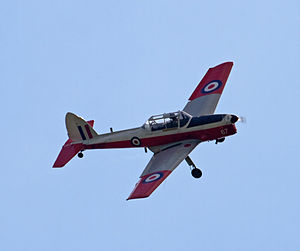
| |
| A Chipmunk 1 in 2013 | |
| Role | Trainer |
| Manufacturer | de Havilland Canada |
| Designer | Wsiewołod Jakimiuk |
| First flight | 22 May 1946 |
| Introduction | 1946 |
| Retired | 1972 (Canada) |
| Primary users | Royal Air Force Royal Canadian Air Force Portuguese Air Force Belgian Air Force |
| Produced | 1947-1956 |
| Number built | 1283 including Canadian, British, and Portuguese production[citation needed] |
The de Havilland Canada DHC-1 Chipmunk is a tandem, two-seat, single-engined primary trainer aircraft which was the standard primary trainer for the Royal Canadian Air Force, Royal Air Force and several other air forces through much of the post-Second World War years. The de Havilland Chipmunk was the first postwar aviation project of de Havilland Canada.
Today, over 500 DHC-1 Chipmunk airframes remain airworthy with more being rebuilt every year.
Design and development
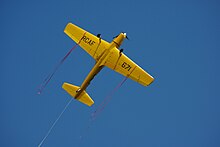


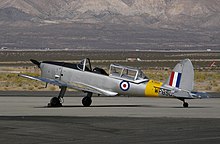
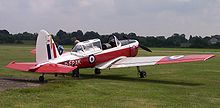
The Chipmunk was designed to succeed the de Havilland Tiger Moth biplane trainer that was widely used during the Second World War. Wsiewołod Jakimiuk, a Polish prewar engineer, created the first indigenous design of the aircraft at de Havilland Aircraft of Canada Ltd. It is an all-metal, low wing, tandem two-place, single-engined aircraft with a conventional tailwheel landing gear and fabric-covered control surfaces. The wing is also fabric-covered aft of the spar. A clear perspex canopy covers the pilot/student (front) and instructor/passenger (rear) positions. CF-DIO-X, the Chipmunk prototype, flew for the first time at Downsview, Toronto on 22 May 1946 with Pat Fillingham, test pilot from the parent de Havilland company, at the controls.[1] The production version of the Chipmunk was powered by a 145 hp (108 kW) inline de Havilland Gipsy Major 8 engine while the prototype was powered by a 145 hp (108 kW) de Havilland Gipsy Major 1C.
Three Chipmunk aircraft serial numbers 1, 10 and 11[citation needed], were evaluated by the Aeroplane and Armament Experimental Establishment (A&AEE) at RAF Boscombe Down. As a result, the fully aerobatic Chipmunk was ordered as an ab initio trainer for the Royal Air Force (Prince Philip took his first flying lesson in one in 1952).[citation needed] The Royal Canadian Air Force also adopted the Chipmunk as their primary trainer.
British-built and early Canadian-built Chipmunks are notably different from the later Canadian-built RCAF/Lebanese versions. The later Canadian-built aircraft have a bubble canopy, while early Canadian, and all Portuguese and British examples have the multi-panelled sliding canopy, the rearmost panels of which are bulged for better instructor visibility.
From the 1950s onward, the Chipmunk also became a popular civilian aircraft, being used for training, aerobatics and crop spraying. Most civilian aircraft are ex-military.
A cabin development of the Chipmunk with side-by-side seating was designed as the DHC-2, but not built.[2]
Operational history
United Kingdom
The RAF received 735 Chipmunks, designated de Havilland Chipmunk T.10, manufactured in the UK by the de Havilland parent company to Air Ministry specification 8/48 as a Tiger Moth replacement. Production began at the DH Hatfield factory but soon transferred to their plant at Hawarden Airport, Broughton near Chester. They initially served with Reserve Flying Squadrons (RFS) of the RAF Volunteer Reserve (VR) as well as the University Air Squadrons. Chipmunks were pressed into service in Cyprus on internal security flights during the conflict in 1958. Eight disassembled aircraft were flown out in the holds of Blackburn Beverley transports. After reassembly, they operated as 114 Squadron for some months into 1959.[3] From 1956 to 1990 the Chipmunks of the RAF Gatow Station Flight were used for covert reconnaissance by BRIXMIS over the Berlin area.[4] Chipmunk T.10s were also used by the Army Air Corps and Fleet Air Arm for primary training.
Chipmunks remained in service with ATC Air Experience Flights until 1996 (the final AEF to use the Chipmunk was No. 10 Air Experience Flight, RAF Woodvale) when they were replaced by the Scottish Aviation Bulldog. The last Chipmunks in military service are still operated by the British historic flights – the RAF Battle of Britain Memorial Flight (including one of the Gatow aircraft), the Royal Navy and Army historic flights, to keep their pilots current on tailwheel aircraft. The cockpit sections of some former RAF Chipmunks have been used as ground training aids. These are colloquially known as "Chippax" trainers.[5] [N 1].
Canada
The RCAF accepted its first DHC-1 Chipmunks in 1948, as the first of a long production run of the 217 Chipmunks made in Canada. The Chipmunk was the first Canadian-designed aircraft to be made abroad under licence, with the majority of the home-grown production destined for the RCAF, but Canadian Chipmunks were also sent to Egypt, Lebanon and Thailand.[6]
Of the 113 in RCAF service, 79 Chipmunks were assigned as ab initio trainers with 34 assigned to flying clubs for use in refresher training for RCAF Reserve pilots.[7] The last example remained in service as a CF trainer until 1972, three years after unification in 1968.[6] The Chipmunk's long service was due, in part, to its fully aerobatic capabilities and superb flying characteristics, which made it a delight to fly.[N 2] It is also a mechanically sound aircraft and, consequently, many ex-RCAF Chipmunks are still operational around the world.[8]
Landing his Chipmunk at Pearson International Airport in Toronto, Ontario, Canada, on 2 June 2015, retired de Havilland Canada test pilot George Neal set the world record for oldest active licensed pilot at the age of 96 years 194 days.[10][11]
Production
Downsview built 217 Chipmunks, the last in 1956.[12] A total of 1,000 were built in Britain initially at Hatfield Aerodrome and then later at Hawarden Aerodrome.[13] A further 66 Chipmunks were licence-manufactured by OGMA (Oficinas Gerais de Material Aeronáutico), at Alverca from 1955 to 1961 in Portugal for the Portuguese Air Force.[14]
Variants
Canadian-built
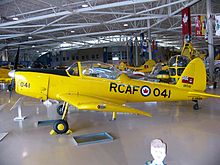
- DHC-1A-1 (Chipmunk T.1)
- Powered by de Havilland Gipsy Major 1C engine, only partially aerobatic.
- DHC-1A-2
- Powered by de Havilland Gipsy Major 10 engine, only partially aerobatic.
- DHC-1B-1
- Powered by de Havilland Gipsy Major 1C engine, fully aerobatic.
- DHC-1B-2
- Powered by de Havilland Gipsy Major 10 engine, fully aerobatic.
- DHC-1B-2-S1
- Powered by de Havilland Gipsy Major 10 for Royal Egyptian Air Force.
- DHC-1B-2-S2
- Powered by de Havilland Gipsy Major 10 for Royal Thai Air Force.
- DHC-1B-2-S3 (Chipmunk T.2)
- Powered by de Havilland Gipsy Major 10 for RCAF refresher training operated by Royal Canadian Flying Clubs.
- DHC-1B-2-S4
- Version for Chile
- DHC-1B-2-S5 (Chipmunk T.2)
- Built for Royal Canadian Air Force.
British-built

- Chipmunk T.10 (Mk 10)
- de Havilland Gipsy Major 8 engined version for the Royal Air Force, 735 built.
- Chipmunk Mk 20
- Military export version of T.10 powered by de Havilland Gipsy Major 10 Series 2 engine, 217 built.
- Chipmunk Mk 21
- Civil version of Mk 20 but fitted to civil standards, 28 built.
- Chipmunk Mk 22
- T.10 converted for civilian use. Conversion also involves restamping the Gipsy Major 8 (which is military) to a model 10-2 (which is civil).
- Chipmunk Mk 22A
- Mk 22 with fuel tankage increased to 12 Imperial gallons per side vs. 9.
- Chipmunk Mk 23
- Five converted T.10s powered by de Havilland Gipsy Major 10 Series 2 engine and with agricultural spray equipment.[13]
Portuguese-built
- Chipmunk Mk 20

Military version powered by de Havilland Gipsy Major 10 Series 2 (145 hp) engine, 10 built in UK followed by 66 built by OGMA.[14] From 1989 onward, seven aircraft where updated and modified at OGMA (5) and Indústrias Aeronáuticas de Coimbra (2) to be used by the 802 Sqn. "Águias" (Eagles) — Air Force Academy squadron. The main modification was the installation of a more powerful 180 hp Continental engine. Their main tasks are related to supporting the Air Force cadets aerial activities, mainly initial aptitude screening, glider tow and initial flight proficiency.
Civil conversions
- Masefield Variant
- Modifications or conversions by Bristol Aircraft Ltd. Modifications could be made on Chipmunk Mk 20, Mk 21, Mk 22 and 22A aircraft. The Chipmunks could be fitted with luggage compartments in the wings, a blown canopy, landing gear fairings and enlarged fuel tanks.[15]

- Super Chipmunk
- Single-seat aerobatic aircraft, powered by a 194 kW (260 hp) Avco Lycoming GO-435 piston engine, equipped with revised flying surfaces and retractable landing gear; four conversions.[16]

- Turbo Chipmunk
- In 1967–1968 a Chipmunk Mk 22A was converted, tested and flown by Hants and Sussex Aviation. The Chipmunk was fitted with an 86.42-kW (116-shp) Rover 90 turboprop engine.[17] and extra fuel capacity.
- Aerostructures Sundowner
- One Australian Chipmunk was fitted with a 180 hp (134 kW) Lycoming O-360 flat-four piston engine, wingtip tanks, clear-view canopy and metal wing skinning as the Sundowner touring aircraft.[18]
- Sasin Spraymaster
- Three Australian Chipmunks were converted into single-seat agricultural spraying aircraft.[18]
- Supermunk
- Designed and produced by officers of the British Gliding Association (BGA)[citation needed], Supermunk aircraft were converted from Chipmunks by fitting 180hp Avco Lycoming O-360-A4A engines for use as glider tugs.[19] Operated mainly by the Royal Air Force Gliding & Soaring Association (RAFGSA), the Supermunks are still in service and used at major gliding competitions in the United Kingdom.[citation needed] It is also used by the Portuguese Air Force Academy as basic training aircraft and as glider tug.[citation needed]
Scholl Super Chipmunk

A number of Chipmunks were modified as aerobatic aircraft in the United States as the "Super Chipmunk". Along with an uprated engine, the aircraft underwent an extensive makeover including clipping its wings, adding retractable landing gear, conversion to a single-seat layout, adding an autopilot and being fitted with a red, white and blue wingtip and tail smoke system. The control stick received a three-inch (76 mm) extension for greater control during extreme aerobatic maneuvers. For over 25 years the Super Chipmunk in its distinctive bright colour scheme of blue stars and sunburst effect was displayed by the aerobatic pilot Art Scholl.
Four Super Chipmunk conversions were modified, Scholl's N13A and N13Y, Harold Krier’s N6311V and Skip Volk's N1114V. Another more recent "Super Chipmunk" was converted by air show performer, Jim "Fang" Maroney who similarly modified an ex-RCAF example by strengthening the airframe, replacing the original 145 hp (108 kW) engine with a 260 hp (190 kW) version incorporating an inverted fuel and oil system, clipping three feet off the wings and adding 30% more rudder and 10% more elevator. A spatted landing gear was retained. Another similarly modified "Super Chipmunk", N1804Q, is owned and flown by air show pilot Greg Aldridge. N13Y is now on display at the National Air and Space Museum, Smithsonian Institution, Udvar-Hazy Center at Washington-Dulles International Airport.,[16] while N1114V is preserved at the EAA AirVenture Museum at Oshkosh, Wisconsin, USA.[20]
Operators
Civilian operators
Today, the Chipmunk remains popular with specialized flying clubs and is also operated by private individuals located in many countries worldwide.
Military operators
- Belgian Air Force (Two operated from 1948 for evaluation)
- Israeli Air Force - One aircraft only.
- Portuguese Air Force
- Squadron 802, Águias (Sintra)
- Air Force Academy (Academia de Força Aérea, Sintra)
- Spanish Air Force - One aircraft only.
- Rhodesian Air Training Group 4 Flying Training School. One aircraft WG354 preserved by South African Airforce Museum
- Royal Thai Air Force, developed as RTAF-4

- British Army - Army Air Corps
- Basic Fixed Wing Flight
- Army Air Corps Historic Aircraft Flight
- Royal Air Force
- RAFVR RFS, No.8 Sqn, No.31 Sqn, No.114 Sqn, No.275 Sqn, No.613 Sqn,[21] No.663 Sqn,[22] RAF Gatow (Berlin) Station Flight, University Air Squadrons, Air Experience Flights (Air Training Corps), Battle of Britain Memorial Flight
- Royal Navy - Fleet Air Arm
Specifications (DHC-1 Chipmunk)

Data from The de Havilland Canada Story [23]
General characteristics
- Crew: 2, student & instructor
Performance
See also
Aircraft of comparable role, configuration, and era
Related lists
References
Notes
- ^ "Chippax" is an amalgamation of "Chipmunk" and "Pax" (an industry abbreviation for "passenger")
- ^ The Chipmunk's flight characteristics have been favourably compared to that of the Supermarine Spitfire.[8][9]
Citations
- ^ Bain 1992, p. 141.
- ^ "tiger moth | 1946 | 1203 | Flight Archive". Flightglobal.com. Retrieved 18 July 2014.
- ^ FlyPast No.282 February 2005 pp74-5
- ^ Shields et al. 2009, p. 276.
- ^ "Chippax." Sywell Museum. Retrieved: 21 July 2011.
- ^ a b "de Havilland Canada DHC-1B2 Chipmunk 2." Canada Aviation and Space Museum. Retrieved: 26 July 2011.
- ^ "De Havilland Canada DHC-1 Chipmunk." Canadian Centennial of Flight, 2009. Retrieved: 26 July 2011.
- ^ a b "de Havilland Canada DHC-1 Chipmunk." Canadian Warplane Heritage Museum. Retrieved: 26 July 2011.
- ^ Shields, Hugh et al. 2009, pp. cover, back cover.
- ^ Anonymous, "World's Oldest pilot," Aviation History, November 2015, p. 10.
- ^ Lynch, Kerry , "George Neal Enters Guinness Record Book as Oldest Pilot," ainonline.com, June 22, 2015
- ^ Shields et al. 2009, p. 211.
- ^ a b Jackson 1987, p. 534.
- ^ a b Niccoli 1998, p. 27.
- ^ "Masefield Chipmunk." Flight, 15 July 1960.
- ^ a b "De Havilland-Canada DHC-1A Chipmunk, Pennzoil Special." Smithsonian, Air and Space Museum, 2005. Retrieved: 6 February 2009.
- ^ Jackson 1987, p. 535.
- ^ a b Eyre 1983, p. 189.
- ^ Taylor, John W. R. Jane's All the World's Aircraft 1982-83. London: Jane's Publishing Company, 1983. ISBN 0-7106-0748-2.
- ^ "de Havilland DHC-1B-2 Chipmunk - N1114V." AirVenture Museum. Retrieved: 6 February 2009.
- ^ Halley 2003, p. 21.
- ^ Halley 2003, p. 76.
- ^ Hotson 1983, p. 237.
Bibliography
- Bain, Gordon. de Havilland: A Pictorial Tribute. London: AirLife, 1992. ISBN 1-85648-243-X.
- Eyre, David. "Sasin/Aerostructures SA29 Spraymaster." The Illustrated Encyclopedia of Aircraft in Australia and New Zealand. Hornsby NSW: Sunshine Books, 1983. ISBN 0-86777-272-7.
- Fisher, Bill. Chipmunk: The First Forty Years. Berkhamsted, Hertfordshire, UK: de Havilland Type Design Organisation, 1986.
- Fisher, Bill. Chipmunk: The First Fifty Years. Berkhamsted, Hertfordshire, UK: de Havilland Type Design Organisation, 1996.
- Halley, J.J. Royal Air Force Aircraft WA100 to WZ999. Tonbridge, Kent, UK: Air-Britain (Historians) Ltd., 2003. ISBN 0-85130-321-8.
- Hotson, Fred. The de Havilland Canada Story. Toronto: CANAV Books, 1983. ISBN 0-9690703-2-2.
- The Illustrated Encyclopedia of Aircraft (Part Work 1982-1985). London: Orbis Publishing.
- Jackson, A.J. British Civil Aircraft since 1919 Volume 2. London: Putnam, 1974. ISBN 0-370-10010-7.
- Jackson, A.J. De Havilland Aircraft since 1909. London, Putnam. Third edition, 1987. ISBN 0-85177-802-X.
- Niccoli, dott Riccardo. "Atlantic Sentinels: The Portuguese Air Force since 1912". Air Enthusiast, No. 73, January/February 1998. pp. 20–35. Stanford, UK: Key Publishing. ISSN 0143-5450.
- Shields, Hugh et al. The de Havilland Canada DHC-1 Chipmunk: The Poor Man's Spitfire. St. Thomas, Ontario: SBGB Publishing, 2009. ISBN 978-0-9812544-0-1.
- Taylor, John W. R.. Jane's All the World's Aircraft 1982-83. Jane's Publishing Company. London. 1983. ISBN 0-7106-0748-2
External links
- RAF Museum
- National Air Force Museum of Canada
- "The D.H. Chipmunk" a 1947 Flight article
- "The Turbine Chipmunk" a 1967 Flight article on the Rover TP.90 experiments
- "In Vogue Again: The de Havilland Chipmunk" a 1974 Flight article
- Article on the RAF BBMF (Battle of Britain Memorial Flight)
